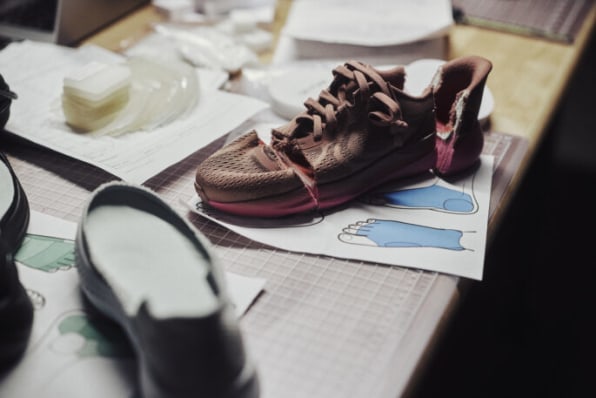
12 Feb A conversation with Lululemon’s CEO five years into the job: How he tripled revenue and is handling the company’s diversity crisis
Calvin McDonald is a busy man. Five years ago, he became Lululemon’s CEO, helping to drive the brand’s revenue from $3.3 billion in 2018 to $9.6 billion in 2023, and quadrupling the brand’s international footprint. It’s arguably one of the most impressive success stories in retail, especially when you consider that much of that tenure was during the pandemic.
As the leader of a performance activewear brand, McDonald likes to stay close to Lululemon’s customers, ambassadors, and employees by taking part in the brand’s athletic events. In December, he joined 30 Lululemon employees at an Ironman event in Indian Wells. And he’s about to join the brand’s ambassadors at a three-day training camp in San Diego.
But McDonald has also had to confront a string of crises over the last few months. This past November, Business of Fashion published a damning exposé of Lululemon that asserted its corporate culture is unwelcoming of Black people. Then, in January, Lululemon’s founder, Chip Wilson, told Forbes that he didn’t like the company’s “whole diversity and inclusion thing” and that “you don’t want certain customers coming in.” Even though Wilson left his CEO position two decades ago, his comments provoked another round of backlash against Lululemon.
McDonald posted a note on LinkedIn to refute Wilson’s comments, but he hasn’t been particularly outspoken about these issues with the public, preferring to address them internally. I sat down with McDonald to talk through his plan for making Lululemon’s culture more inclusive and continuing the brand’s remarkable growth trajectory.

Fast Company: Chip Wilson sparked a lot of anger when he said Lululemon is not for everyone. What were your thoughts when you read that?
Calvin McDonald: Chip does not speak for Lululemon. He may have started the Lululemon, but he has not built this company. When he was last CEO nearly 20 years ago, revenue was around $80 million. We’re now approaching $10 billion in revenue. We have 35,000 employees, none of which were here in the organization when Chip was last CEO.
We’ve moved well beyond his misguided views to one where we want everyone to feel they belong at Lululemon. I’m proud of that shift and I think it’s resonating.
There have been reports that Black employees don’t feel comfortable at the company. What are you doing to address those issues?
I’m personally committed to our BIPOC community. And to show it, I started monthly listening sessions three years ago. They’re a forum where I can hear unfiltered feedback from BIPOC employees about what’s working and what’s not. I’ve spent more than a hundred hours in these sessions.
The IDEA [Inclusion Diversity Equity and Action] team makes an open invitation to everyone at the company. We have anywhere from 20 to 40 employees, who come from across the company, including distribution centers and retail stores. Some are full-time, some are part-time. We move the timing around, to make it more convenient for employees around the globe.
Some people just come and listen. Many share their lived experiences. I think, at the heart of DEI, the goal is to never stop talking to one another. It is rooted in two-way dialogue. And I believe that by being there, I convey a sincere intention to make an impact.
Many of the things that people share in these meetings is confidential. But I can say that it has been incredibly helpful and has led a lot of tangible results that are driving the IDEA work. For instance, it led to the creation of People Networks. [There are eight employee-led, company-funded resource groups for Black, Indigenous, Lantix, Chronic Illness, Mental Health and Disablities, South Asia, Asian, Women in STEM and LGBTQIA+ communities, providing space for connection and professional development.] It also helped us create training for store employees to coach them on how to create more inclusive environments.

How are you thinking about DEI these days?
We used to say that we hired for “culture fit.” But I made the pivot for everyone at the company to say “culture add.” This allows us to be more deliberate about creating a space where everyone can be their authentic self and recognize the value in diversity.
And when it comes to equity, we believe that our employees should have equal pay for equal work. Historically, we’ve been leaders when it comes to gender pay equity and we’re now leading with equity across races.
When it comes to diversity, we don’t believe in having quotas, but we do push our teams to interview a diverse slate of candidates to find the best talent and to fully represent the communities we serve. I’m proud of what we’ve achieved thus far. We met our goal of having 40% racially diverse representation within our stores, which is a more than 10% increase from the year before. We still have more work to do and I’m incredibly committed to it.
Tripling revenue growth in five years is impressive—and two of those years, we were in the pandemic. What was your plan of attack when you started out in 2018?
When I joined, I didn’t inherit a broken brand. But what I saw was an opportunity to achieve a much greater impact.
It comes down to being very clear on the brand’s story, which is rooted in the concept of well-being. It’s about helping people feel their best, and we’ve found it’s a message that resonates across geographies, generations and culture.
We started as a women’s brand, but we’re now firmly a dual gender brand. And we now have multiple wear occasions, from our performance to our lounge collection to pieces that people wear for social occasions. And we’re now a truly global brand, quadrupling our international footprint. In China alone, we went from 13 stores to 130.

What do you think is the main driver of success?
It comes down to putting product at the center. Our goal is to solve unmet needs for our guests. Internally, we talk about it as the “science of feel.” What is the feeling—the sensorial state—the guest is looking for? Once we understand that, we innovate to create it.
This is why our “Align” franchise is now a billion dollar business. It is made of this fabric called Nulu that has compression, but is also buttery soft. We don’t use common fabrics that are widely available to any brand. We invest a lot in innovating our own materials. And it’s also about sustainability. We’ve created new bio synthetics and created the world’s first polyester that uses captured carbon emissions. I believe this is what has driven our success, and we’re going to keep doing it.
Lululemon’s leggings arguably started the athleisure trend, which has been driving fashion for the last decade. Do you see Lululemon as a fashion trendsetter? No. We’re not a fashion brand. We’re an innovative, performance brand that delivers on people’s needs. I think that will continue to resonate and deliver quarter after quarter, even as trends change.
We proved this out during the pandemic. We could bet on inventory that our competitors could not because a large portion of our sales come from our core pieces that don’t change. This allowed us to have inventory and grow even during those supply chain disruptions.

Several years ago, I reported on Lab, the fashion-forward streetwear line you’re creating. How does that fit into your strategy now?
Lab’s a very small portion of our business. The goal is to have a sandbox where designer can play and learn. I tell the team that it gives them permission to fail. They can test a product, an aesthetic or a fabric—test the execution—and see how the guest resonates and responds to it. Successes feed into the core collection; we chalk up failures to learning. It’s worked well. A lot of our newest fabrics initially launched in Lab and some version goes into the mainline collection.
Two years ago, you launched women’s footwear. And this past week, you debuted your first men’s shoes. Is this a big part of your business going forward?
Footwear is a category where we see a lot of opportunity to disrupt and bring our unique approach to innovation. I remember meeting with the footwear team in Portland early into my time here at Lululemon. I learned that pretty much the entire industry launches women’s footwear built on the model of a man’s foot. But women’s feet and bodies are so different.
So I had one of those moments where I made an executive decision and said we’re going to hold the men’s shoe, and launch with women’s. That’s example of an unmet need. We’re only two years into footwear and we’re pleased with our early results. We see significant runway for growth.
Source: Fast Company




Sorry, the comment form is closed at this time.